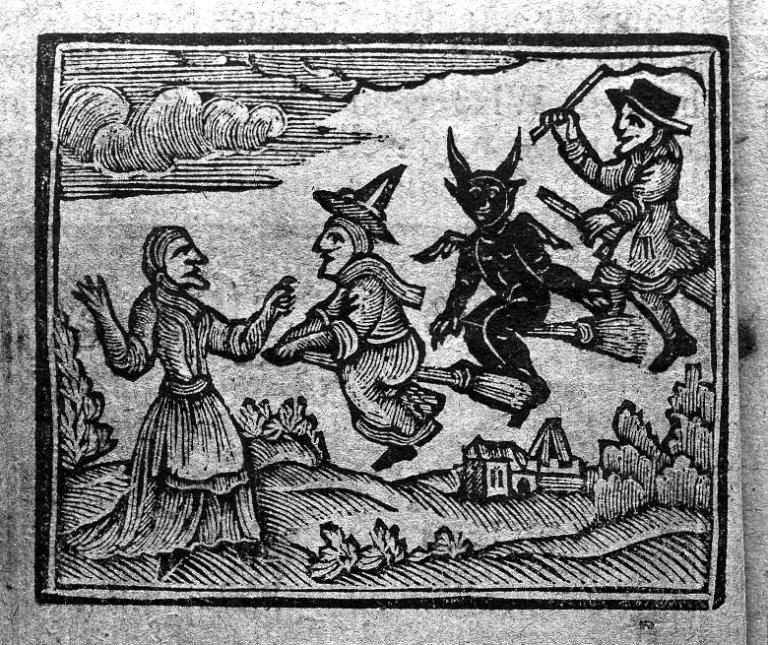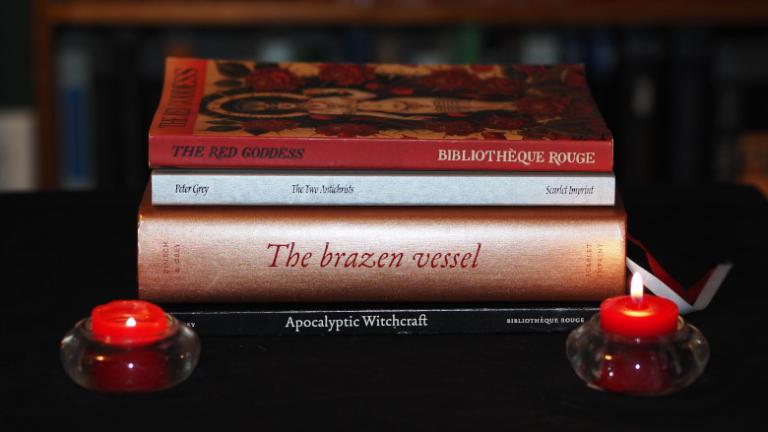Jon Goodfellow asked a question that probably would be better answered by someone with more direct experience in the matter. But he asked me, so I’m going to answer.
Do you feel that the folkloric devil can fit into multiple pantheons for a witch who honors specific Gods? If so, do you think it makes the most sense to think of him as a person separate from the pantheon (sort of a “houseguest”) or syncretized within it (devil is Odin/Woden, etc.)?
Let’s begin with an important point. The folkloric devil is not the devil they told you about in Sunday School, who “walketh about seeking whom he may devour.” The Sunday School devil may or may not exist, but he cannot be who and what Christians claim he is outside of a conservative Christian worldview, a worldview that is at odds with history, science, and our own experiences.
This emphasizes the importance of examining our worldview: our foundational assumptions about the world and how it works, about what is and isn’t possible.
My worldview is built on a foundation of animism and polytheism. Therefore, I believe the Christian God exists, but He is one God among many – not the only God and certainly not a “supreme being.” And likewise, the Christian devil is not “the adversary” or the embodiment of evil, but one spirit among many.
I agree with our atheist friends (and more than a few Christians) that much of what is attributed to the devil is simply humans making excuses for their own selfish and destructive behavior.

The devil in witchcraft lore
There are three main sources for the devil in our witchcraft lore.
The first are the grimoires, the medieval and early modern books of spirits and instructions on how to summon them. Most of these spirits are demons. The details are beyond the scope of this post – for a good modern take on this read Jason Miller’s Consorting With Spirits. What’s important for us here is that ceremonial magicians attempted to summon these spirits and compel the spirits to work for them. The books, methods, and the ideas that come from them are still very much with us.
The second are the records of the witch trials. Yes, most of the “evidence” was obtained under torture and is unreliable. That’s not the point. The point is that the idea of witches “consorting with the devil” entered into mainstream Western culture and it’s been there ever since.
The third source is folk magic itself – the magic done by ordinary people for ordinary reasons. In a time when Christianity completely dominated Western culture, such magic was done in a Christian context – it could not be otherwise. Jason Mankey’s 2019 post Why Can’t There Be Christian Witches? explores this in more detail. Much of this magic invokes the power of saints, scripture, and the Christian God. It is not orthodox Christianity, but it is Christian.
Some of this magic crosses a line. If there are only two options and you can’t get what you need from Jesus, you go to the other guy. Desperate people do desperate things, and the price isn’t necessarily your soul.
For modern witches, there are more than two options. But the devil is part of witchcraft lore, and some choose to work with him.
The story of the devil was written by his enemies
Who is the devil? Are Lucifer, Satan, and Beelzebub the same person or different spirits? Are they completely evil, seeking only to corrupt and destroy? Or were they simply on the losing side?
History is written by the winners. So are myths.
What does the story of the devil look like through a polytheist lens?
A plain reading of the story of Lucifer tells us that a group of angels (beings who are powerful but not quite Gods) got tired of serving their God – who, let’s not forget, is not the only God but one God among many. So they left Heaven (i.e. – that part of the Otherworld, or if you prefer, one of many Otherworlds) either voluntarily or by force and they came to Earth, where various legends say they rule this or that region or realm.
As an aside, I tend to think they didn’t find the Earth empty when they got here. Some Christians claim that fairies are fallen angels. I think they’re competitors with the fallen angels – and with humans, and perhaps others – for control of the Earth.
Going further, a plain reading of the story of Eden says that the Christian God tried to keep the first humans in ignorance. It was the serpent – generally presumed to be Lucifer in another form – who gave them the knowledge of good and evil, which enabled them to become adults.
Who’s the bad guy in this story?
Satan as a symbol of rebellion against unjust authority
Authorities don’t like rebellion. Authorities like nice, compliant sheep who do what they’re told and who don’t challenge the structures that keep said authorities in power. Now, civilizations require order – they require laws and customs and structures to provide a foundation for the human activities that ensure security and expand knowledge. I’m rather fond of order. But even I can see that many of our current structures have become dysfunctional, and many more have been hijacked to enforce conformity and to serve the rich and powerful.
In a society that is still heavily influenced by Christianity, the devil is the ultimate symbol of rebellion against authority and structure.
The Satanic Temple is an atheist organization, but the metaphor of Satan perfectly matches their work to promote individual freedom and to oppose government endorsement of any one religion. Political and social conservatives often claim the authority of the Christian God to justify their oppression – The Satanic Temple uses the power of myth to fight them.
As another aside, The Satanic Temple does good work and I consider them allies in the cause of freedom and justice. But they are explicitly anti-theist and anti-magic – I would not be welcome in their organization and so I have no intentions of joining it. That’s OK – everything doesn’t have to be for everyone.
Witchcraft is inherently anti-authoritarian
These days many different people are calling themselves witches for many different reasons. I do my best to stay out of the arguments about who is or isn’t a witch. But I do have a definition of witchcraft.
Witchcraft is unauthorized magic.
Witchcraft is magic done for the witch’s own reasons. Witchcraft doesn’t ask permission. Most witches are ethical people, but their ethics are their own, not the ethics of the mainstream culture – and certain not the ethics of the Christian patriarchy. Witchcraft says “as I will it, so mote it be!”
Is it any wonder that those in charge still scream “witch!” when anyone – especially a woman, especially a woman claiming power – challenges authority?
Is it any wonder that many witches are inspired by the story of Lucifer and his cry of non serviam (which, contrary to what many think, did not originate with Milton but with James Joyce)?
A Luciferian revolt
Peter Grey, author of Apocalyptic Witchcraft and co-author of The Brazen Vessel, argues because our society is still dominated by Christianity, our response must be rooted in Christianity. In an essay titled “The Luciferian Revolt” Grey wrote:
In the West we are culturally Christian. The book which has formed and transformed our spirituality, our institutions, our laws, our art, our ideas of witchcraft is the Bible. Therefore our witchcraft must also relate to this set of cultural stories, or it is meaningless. We cannot cherry pick pagan pasts and in doing so, neglect the serpent and the apple.
I find Peter Grey’s work inspiring. He’s certainly not wrong here. Like The Satanic Temple, this sort of witchcraft grabs the attention of the mainstream society and turns it upside down. It screams “your religion is so harmful I would rather identify with your adversary.”
And as magicians throughout the past millennium – including today – can attest, the devil can be a powerfully ally.
But is he the best ally in a society where Christianity is already in steep decline? Do we need to continue to rebel against Christianity, or are we better served by simply walking away from that which does not support us and walking toward a future grounded in animism and polytheism?

Witchcraft without the devil
Cernunnos teaches me about life and death in this world. The Morrigan teaches me to fight for what is right, and for what is rightfully mine. One of the epithets of Isis is “Mistress of Magic.” For me, this is enough.
And also, I needed to make a clean break with Christianity. I’m even further down the road of healing now than I was when I wrote that post six years ago – I’m not worried about a relapse. But I’m also further down this path of Paganism and I simply see no reason to ground my witchcraft in a mythology that doesn’t speak to me.
We must all do what we believe is best. Witchcraft is magic done for the witch’s own reasons, with the methods and stories and allies that speak to the individual witch. But I see no reason to work with the devil.
The devil as an extended member of a court
For those who do, where does the devil best fit into a family of Gods and spirits?
I think Jon Goodfellow’s first suggestion is the best option. Pagan and polytheist witches who work with the folkloric devil would be best served by considering him a guest in a pantheon. Or even better, as an extended member of the court of the deities the witch honors. He is not part of any of the European hearth cultures, and while I’m the last person who will call for cultural purity, some combinations just don’t fit.
Gods and other spirits can fill the roles performed by the devil and they do in some traditions, but I’m reluctant to call that a syncretism.
Just because you choose to ignore the devil doesn’t mean the devil will choose to ignore you. I do not believe he is a “tempter” trying to corrupt your soul. But working magic – any magic, especially big magic – shines a light into the spirit world. You never know who’s attention you may catch.
If you catch the attention of the devil, it’s best to know what he is – and what he isn’t.














